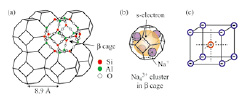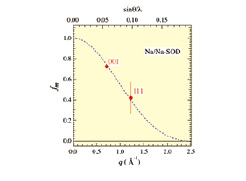Direct Observation of Antiferromagnetic Order by Neutron Diffraction of s-Electrons Confined in Regular Nanospace of Sodalite
T. Nakano and M. Matsuura
Various kinds of magnetically ordered state, such as ferromagnetism, antiferromagnetism, and ferrimagnetism, have been found in alkali metal nanoclusters arrayed in regular nanospace of aluminosilicate zeolite crystals. The magnetic properties depend on the zeolite framework structures, the species of alkali element and the electron density of the clusters. They are quite a new class of magnetic materials because the magnetic orderings are realized by the mutual interaction between s-electrons confined in the nanospace and they contain no magnetic elements such as transition metal or rare earth metal. In this article, we report the first direct observation of long-range magnetic ordering of s-electrons by neutron diffraction (ND) [1].

Fig. 1. Schematic illustrations of (a) crystal structure of aluminosilicate sodalite, (b) Na43+ cluster formed in the β-cage, and (c) magnetic structure model of Na clusters in sodalite. The framework of sodalite consists of Si, Al and O covalent-bonding network. The β-cages with an inner diameter of 0.7 nm are arrayed in a bcc structure. In the Na43+ cluster, one unpaired s-electron is shared among four Na+ ions and confined in the β-cage. Under the antiferromagnetic ordered state, the electronic spin in the body center cluster and that in the corner cluster are coupled in antiparallel in the bcc lattice.

Fig. 2. Magnetic form factor of Na clusters in sodalite for scattering vector q. The closed circles show experimental results obtained by 001 and 111 magnetic Bragg peaks. The dotted curve shows the form factor evaluated from the 1s wave function in the spherical well potential with the inner diameter of 0.7 nm.
Sodalite is a kind of aluminosilicate zeolites. As shown in Fig. 1 (a), truncated-octahedron-shaped β-cages are arrayed in a body-centered cubic (bcc) structure. The inside diameter of the β-cage is approximately 0.7 nm. The framework Al3Si3O12 is negatively charged and three Na+ ions are distributed in the cage. By the loading of guest Na atom into sodalite, Na43+ cluster can be formed in the β-cage as shown in Fig. 1 (b). In the cluster, one unpaired s-electron provided by the guest Na atom is shared among four Na+ ions and confined in the cage. When the clusters are formed in all the cages, antiferromagnetic (AFM) ordering appears below the Néel temperature of TN = 48 K because of the exchange interaction between adjacent clusters via the window of the cage. The magnetic phase transition has been confirmed by susceptibility, ESR, NMR, μSR and so on, but there have been no reports on determining the magnetic structure. This might be due to the difficulties originated from the large unit cell and resultant low spin density. In the present study, we prepared approximately 2 grams of powder specimen of Na-loaded sodalite and performed ND experiments for the first time by utilizing the spectrometer PONTA at the JRR-3 at JAEA.
We succeeded in observing the 001 and 111 magnetic Bragg peaks at low temperature. The intensity was nearly three orders of magnitude weaker than that of the 011 nuclear Bragg peak. The temperature dependence of the intensity of 001 peak was well fitted by using a phenomenological equation of the order parameter with a three-dimensional Heisenberg antiferromagnet. The simultaneous observation of 001 and 111 magnetic Bragg peaks is consistent with the magnetic structure shown in Fig. 1 (c) where the electronic spin in the body center cluster and that in the corner cluster are antiparallel in the bcc lattice. We also evaluated the magnetic form factor from the ratio of the integrated intensities of the 001 and 111 magnetic Bragg peaks to the 011 nuclear one. The form factor is found to dump very quickly as a function of q as shown in Fig. 2. The simplest model describing the electron wave function of the cluster is a spherical well potential model with the diameter of the cluster. The dotted curve in Fig. 2 shows the calculated form factor of the 1s wave function confined in the spherical well with the inner diameter of 0.7 nm. The calculation results are in good agreement with the experimental ones. Therefore, it is evident that the s-electron responsible for the AFM order possesses a wave function delocalized over nanometer size in the cluster.
References
- [1] T. Nakano, M. Matsuura, A. Hanazawa, K. Hirota, and Y. Nozue, Phys. Rev. Lett. 109, 167208 (2012).
